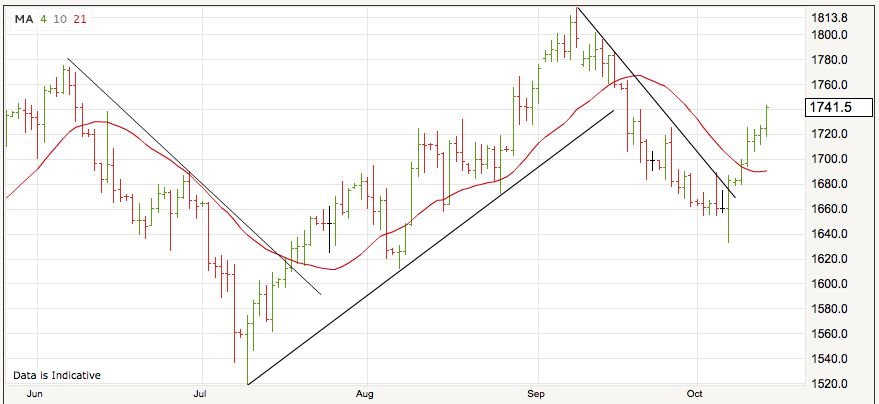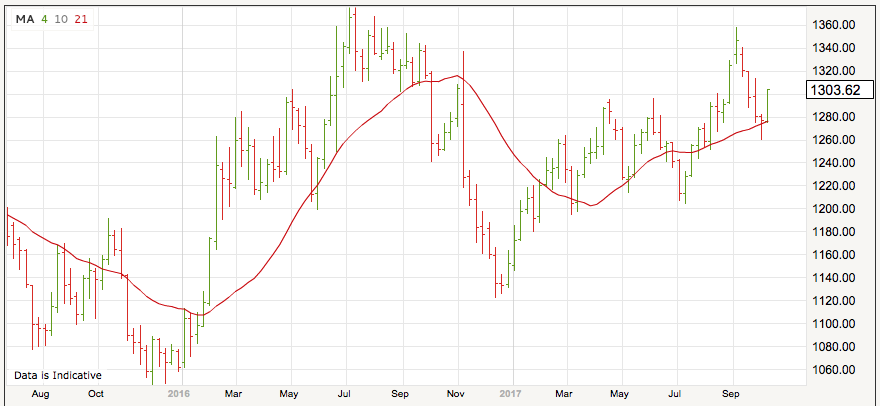-- Published: Friday, 20 October 2017 | Print | Disqus
By James Turk
Leverage is the use of credit or borrowed capital to increase the earning potential of your investment portfolio. But like everything else in finance, higher returns mean higher risk, so leverage is not for everyone.
Nevertheless, leverage can be a useful tool for those accepting the risk. If you choose to use it to maximise the return of your gold and silver, there are two key factors to getting it right.
First, use leverage when the trend is in your favour. So how do you identify the trend? Here are a couple of popular methods.
1) Moving Average – A moving average is constructed by calculating the daily closing price over a period of time. Different time periods can be used for different markets, but for gold and silver, the 21-day and 200-day moving averages are popular measures of short-term and long-term trends.
When using moving averages, the rule is to be in harmony with the trend. This is accomplished by owning gold and silver when their price is above the moving average and the moving average itself is rising. Conversely, if you are trading precious metals as opposed to accumulating it, be out of the market if either or both of these conditions are not met.
It sounds easy, but it’s not. To assist you in identifying the trend, trendlines can be particularly helpful when used in conjunction with a moving average, as illustrated in the following chart of silver’s daily closing price in London.

Note the clear uptrend in the silver price and the downtrends. Note also that a new uptrend in price is just beginning because the silver price is above its 21-day moving average, which itself is turning higher and rising. If history is any guide, now is the time to buy and possibly leverage your purchase with additional silver, if you believe the risk/return suits your investment criteria.
2) Higher Lows – Prices can also point out the trend. For example, the gold price declined from its record high of $1910 per ounce in August 2011 to December 2015 when it reached $1055. Then prices began to rise. Gold eventually retraced that rise, and in December 2016 fell back to $1125, 6.6% above the low price a year earlier.
This year there have been two further retracements occurring after the gold price rose. These advances and retracements are normal patterns, but the important point is that the low price in March was higher than the previous low in December 2016. Similarly, the July low price was higher yet again.
This pattern of rising lows is telling us that the gold price is in an uptrend, as can be seen in the following chart of gold’s weekly closing price in London, with its 21-week moving average that is also rising. So as is the case with silver, now is the time to buy gold and possibly leverage your purchase with additional gold, if you believe the risk/return suits your investment criteria.

Traders and investors have been using these and other techniques throughout the ages to identify price trends. They are not fool proof; nothing is when it comes to investments. But these techniques are useful tools that have proven helpful over time.
View leverage to also be a tool, and like any tool, it needs to be used wisely – or not at all.
Endnote: If you are interested in using leverage with your gold and silver, please read: “A New Way to Leverage Your Gold & Silver”
The views and opinions expressed in this article are those of the author(s) and do not reflect those of Goldmoney, unless expressly stated. The article is for general information purposes only and does not constitute either Goldmoney or the author(s) providing you with legal, financial, tax, investment, or accounting advice. You should not act or rely on any information contained in the article without first seeking independent professional advice. Care has been taken to ensure that the information in the article is reliable; however, Goldmoney does not represent that it is accurate, complete, up-to-date and/or to be taken as an indication of future results and it should not be relied upon as such. Goldmoney will not be held responsible for any claim, loss, damage, or inconvenience caused as a result of any information or opinion contained in this article and any action taken as a result of the opinions and information contained in this article is at your own risk.
| Digg This Article
-- Published: Friday, 20 October 2017 | E-Mail | Print | Source: GoldSeek.com

